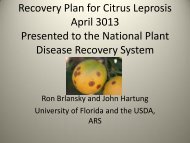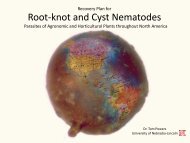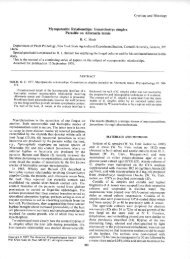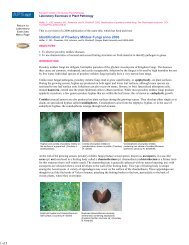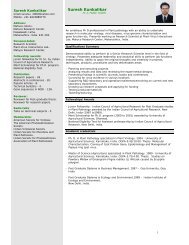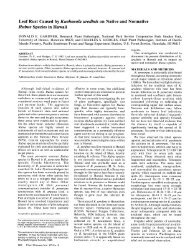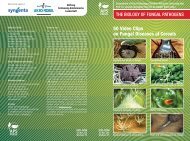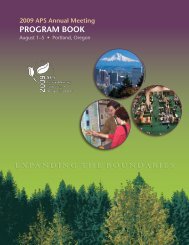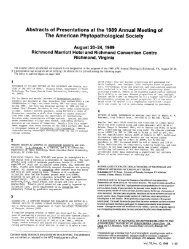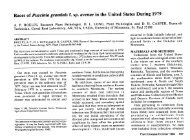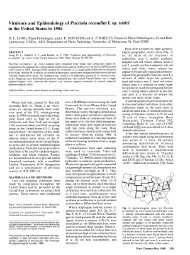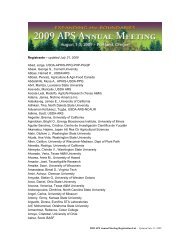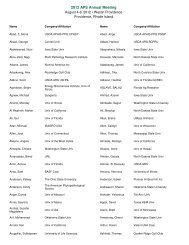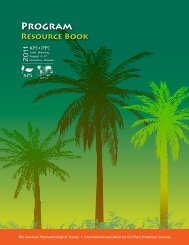See the program book (PDF) - American Phytopathological Society
See the program book (PDF) - American Phytopathological Society
See the program book (PDF) - American Phytopathological Society
You also want an ePaper? Increase the reach of your titles
YUMPU automatically turns print PDFs into web optimized ePapers that Google loves.
P-429 The bacterial phytotoxin coronatine targets <strong>the</strong><br />
Arabidopsis SCF COI1 –JAZ protein complex. J.<br />
YAO (1), C. Mecey (1), M. Melotto (1), W. Zeng<br />
(1), S. He (1). (1) Department of Energy-Plant<br />
Research Laboratory, Michigan State University, East<br />
Lansing, MI, U.S.A.<br />
P-430 Validated Ca. Liberibacter asiaticus genomic DNA<br />
contigs assembled using a metagenomics approach.<br />
D. W. GABRIEL (1), S. L. Reddy (1). (1) University<br />
of Florida, Gainesville, FL, U.S.A.<br />
P-431 Pseudomonas syringae is equipped with diverse<br />
mechanisms to exploit choline and its analogs<br />
from plants. C. CHEN (1), A. A. Malek (2), M.<br />
J. Wargo (2), D. A. Hogan (2), G. A. Beattie (1).<br />
(2) Dartmouth Medical School, (1) Iowa State<br />
University<br />
P-432 Avirulence genes from Xanthomonas axonopodis<br />
pv. glycines causes specific genotype in soybean. D.<br />
ATHINUWAT (2), S. Prathuangwong (2), T. J. Burr<br />
(1). (1) Department of Plant Pathology, College of<br />
Agriculture and Life Sciences, NYSAES, Cornell<br />
University, Geneva, NY, U.S.A., (2) Department of<br />
Plant Pathology, Faculty of Agriculture, Kasetsart<br />
University, Bankok, Thailand<br />
P-433 Characterization of HopA1, a Pseudomonas syringae<br />
type III effector protein. T. Y. TORUÑO (1), M.<br />
Guo (1), J. R. Alfano (1). (1) University of Nebraska-<br />
Lincoln, Lincoln, NE, U.S.A.<br />
P-434 Differential and multiple host susceptibility (S)<br />
genes control <strong>the</strong> interaction of Xanthomonas oryzae<br />
pv. oryzae with <strong>the</strong> host plant rice (Oryza sativa L.).<br />
T. MAHMOOD (2), G. Antony (2), B. Yang (1),<br />
F. White (2). (1) Genetics, Development and Cell<br />
Biology, Iowa State University, Ames, IA, U.S.A., (2)<br />
Plant Pathology, Kansas State University, Manhattan,<br />
KS, U.S.A.<br />
P-435 Two-component signal transduction systems play a<br />
major role in Erwinia amylovora pathogenesis and<br />
survival. Y. ZHAO (1), D. Wang (1), S. Nakka (1).<br />
(1) Department of Crop Sciences, University of<br />
P-436<br />
Illinois, Urbana, IL, U.S.A.<br />
Flash<br />
&<br />
dash Using <strong>the</strong> universal language of Gene<br />
Ontology to annotate gene products involved in <strong>the</strong><br />
interactions between microbes and <strong>the</strong>ir hosts. C. W.<br />
COLLMER (8), T. Torto-Alalibo (7), M. Lindeberg<br />
(1), M. Chibucos (7), M. Gwinn-Giglio (5), B. Biehl<br />
(6), A. Ireland (2), J. Lomax (2), D. Bird (4), A.<br />
Collmer (1), R. Dean (4), J. Glasner (6), L. Hannick<br />
(3), T. Mitchell (4), N. Perna (6), J. Setubal (7), O.<br />
White (5), B. M. Tyler (7). (1) Cornell University,<br />
Ithaca, NY, U.S.A., (2) European Bioinformatics<br />
Institute, Hinxton, UK, (3) J. Craig Venter Institute,<br />
Rockville, MD, U.S.A., (4) North Carolina State<br />
University, Raleigh, NC, U.S.A., (5) University of<br />
Maryland School of Medicine, Baltimore, MD,<br />
U.S.A., (6) University of Wisconsin, Madison, WI,<br />
U.S.A., (7) Virginia Bioinformatics Institute, Virginia<br />
Tech, Blacksburg, VA, U.S.A., (8) Wells College,<br />
Aurora, NY, U.S.A.<br />
P-437<br />
P-438<br />
P-439<br />
P-440<br />
P-441<br />
Flash<br />
&<br />
dash Identifying differences in gene expression<br />
between Race 1 and Race 3 strains of Ralstonia<br />
solanacearum during bacterial wilt disease<br />
development at warm and cool temperatures. J.<br />
M. JACOBS (1), F. Meng (1), C. Allen (1). (1)<br />
University of Wisconsin, Department of Plant<br />
Pathology, 1630 Linden Dr., Madison, WI, U.S.A.<br />
Flash<br />
&<br />
dash Genomics of secondary metabolite production<br />
by Pseudomonas fluorescens Pf-5. J. E. LOPER (3),<br />
I. Paulsen (1), D. Bruck (3), M. Pechy-Tarr (5),<br />
M. Maurhofer (2), C. Keel (5), H. Gross (4). (1)<br />
Macquarie University, Sydney, Australia, (2) Swiss<br />
Federal Institute of Technology, Zurich, Switzerland,<br />
(3) USDA-ARS, Corvallis, OR, U.S.A., (4)<br />
University of Bonn, Bonn, Germany, (5) University<br />
of Lausanne, Lausanne, Switzerland<br />
Flash<br />
&<br />
dash The virulence mechanisms of Xylella fastidiosa<br />
in xylem fluid of citrus and grapevines. X. SHI<br />
(2), J. Bi (1), N. Toscano (1), D. Cooksey (2).<br />
(1) Department of Entomology, University of<br />
California, Riverside, CA, U.S.A., (2) Department<br />
of Plant Pathology and Microbiology, University of<br />
California, Riverside, CA, U.S.A.<br />
Flash<br />
&<br />
dash Differentiation of Xylella fastidiosa subspecies<br />
piercei isolates from a Texas vineyard into strain<br />
groups utilizing simple sequence repeat markers. C.<br />
P. TORRES (1), D. N. Appel (1), L. Morano (2).<br />
(1) Texas A&M University, Department of Plant<br />
Pathology and Microbiology, College Station, TX,<br />
U.S.A., (2) University of Houston-Downtown,<br />
Department of Natural Science, Houston, TX,<br />
U.S.A.<br />
Flash<br />
&<br />
dash A horizontally acquired cellulose synthase<br />
operon in Dickeya dadantii contributes to biofilm<br />
formation and attachment to plants. C. E.<br />
JAHN (1), J. Apodaca (2), N. T. Perna (2), A. O.<br />
Charkowski (1). (1) Department of Plant Pathology,<br />
University of Wisconsin-Madison, Madison, WI,<br />
U.S.A., (2) Genome Center of Wisconsin, University<br />
of Wisconsin-Madison, Madison, WI, U.S.A.<br />
Biological Control<br />
P-442 Galactinol is a signaling component of <strong>the</strong><br />
induced systemic resistance caused by Pseudomonas<br />
chlororaphis O6 root colonization. M. Kim (3),<br />
S. Cho (3), Y. Im (3), H. Hoon (2), Y. Kim (3),<br />
C. Ryu (1), K. Yang (3), G. Chung (3), B. CHO<br />
(3). (1) Systems Microbiology Research Center,<br />
KRIBB, Daejon, South Korea, (2) Department of<br />
Agricultural Biochemistry, College of Agri. and Life<br />
Sci. Chonnam National University, Gwangju, South<br />
Korea, (3) Department of Plant Biotechnology,<br />
College of Agri. and Life Sci., Chonnam National<br />
University, Gwangju, South Korea<br />
P-443 Growth rate and temperature tolerance of diverse<br />
Trichoderma koningiopsis isolates. I. E. YATES (2), S.<br />
Chambliss-Bush (2), G. Samuels (1), D. Sparks (3).<br />
(1) USDA, ARS, Systematic Botany and Mycology<br />
Laboratory, (2) USDA, ARS, TMRU, (3) University<br />
of Georgia, Department of Horticulture<br />
93



